| Web
and Book
design,
Copyright, Kellscraft Studio 1999-2009 (Return to Web Text-ures) |
 (HOME)
|
X
THE CROFTERS OF SKYE 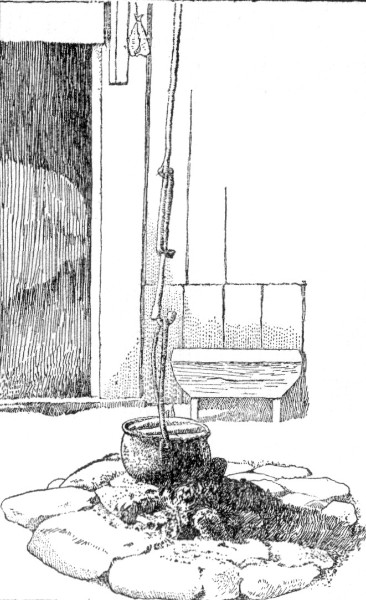 A Fire on the Floor I WAS not returning to Oban. On the contrary I had taken a steamer bound northward for the Isle of Skye. The distance was only seventy-five miles in a direct line, yet our irregular cruising made it an all-day's journey. We zigzagged back and forth interminably between the islands and the mainland, and stopped at every tiniest seaside village. At the larger places we entered a harbor and tied to a pier, but oftenest we simply slowed up in the offing and were met by a rowboat. Every one on board watched the transfer of passengers from the panting, slow-heaving steamer to the wave-tossed smaller craft with keen interest. No mishaps occurred, yet there was always a decided flavor of excitement and danger. Many ducks were afloat on the billows in groups here and there, but at our approach would make hasty dives from sight. Multitudes of gulls, too, were bobbing on the waves, and other multitudes were sitting on the low rocks at the water's edge or were idling about in the air. Sometimes a whole flock of them would be startled to wing from the sea or shore, and there would be so many that they formed a white cloud. Now and then we passed a lighthouse or met a steamer, or had a sailing vessel or two within our horizon, but the prevailing impression was one of loneliness. The coast was rarely if ever lost to sight. Much of it rose in high, rugged cliffs, gray and worn with the unending struggle with the elements, and everywhere inland were great, dark hills lifting often into dim mountains whose higher peaks were hidden by the clouds. Villages were few and far between, and even neighborless single habitations were infrequent. Most of the homes were low, earth-hugging thatched cottages, with walls of dark stone that made the whole structure the same sombre color as the landscape. Of the islands we passed I think I regarded Eigg with greatest interest, for there, long ago, was enacted one of the grimmest of old-time tragedies. It was an incident in the warring of the local clans. The Macleods of Skye had made a successful descent on the island, and all the inhabitants, numbering two hundred, were driven into a big cave near the shore. Then the savage invaders built fires at the mouth of the cave, and those within were suffocated by the smoke, and not one escaped the cruel death. I went "steerage." But steerage on a little coasting steamer is very different from what it is on an ocean greyhound. One would have crowded quarters and the company of the scum of the earth on a transatlantic steamer, while here there was abundant room, and the peasantry and tradespeople who were my fellow-voyagers were in no wise untidy or offensive. I was really quite comfortable, in spite of being excluded from the upper deck and from the cabin at the stern. The person among the passengers with whom I became best acquainted was a heavy, talkative old man. He said he was a native of Skye, and when that island hove into sight he was rapturous. 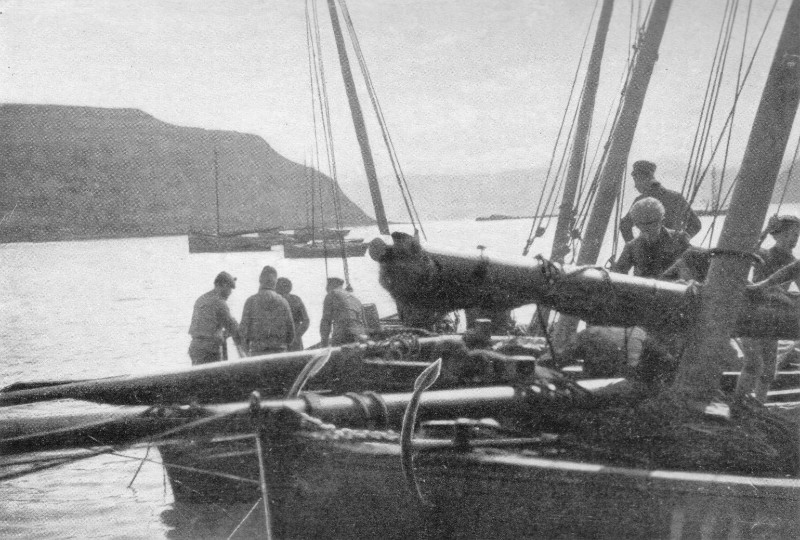 Skye Fishing-boats "Skye is not a place of dear prices," he declared. It's not like Oban. Aha! There they skin the nose off you with their prices. But Skye — Skye is a fine place to live — good fishing — it's healthy — beautiful water for drinking, not the like of it in this wide world; and there's no such scenery anywhere else in Scotland. You want to see the Coolin Hills. But you'll have to have stouter shoes than those you're wearing, if you're going tramping there, and you'll want thick stockings like these I've got on. Feel of 'em. They're stiff — not soft like factory goods. They're homespun, same as my clothes. Those trousers now, the cloth in 'em's just a blanket, only different color, and it washes. When those trousers get dirty all you have to do is to put 'em in a tub with water and soap and tramp 'em out the way they do blankets. Do you see the tips of some hills 'way off ahead? Some of the mountains back in there are black — black as the old Nick! There's a church over on the other shore of that bay we're passing. I know the minister. He got married lately, and I saw his wife when I was there last month. Aha! They're a pair of old fools. What's the good of people's marrying after they get to be sixty! A man's only getting a nurse to take care of him. You get cross by the rime you're sixty, and ill-tempered, and the dickens is to pay!" In the late afternoon we drew near our destination, and the steamer swung around an outjutting of high cliffs into the quiet of Portree harbor, where many little fishing-boats lay softly rising and dipping at their anchorage. For a short time our arrival made great hurly-burly on the pier, and then things quickly subsided to their usual tranquillity. Near by, a squad of stout, kerchiefed-women were busy packing herring in barrels, and a few leathery-visaged fishermen were hulking about. Several small boys were dangling lines from the wharf or from the boats moored along it, and were catching &h from the clear, green seawater as fast as they could pull them in. I would have liked to linger had the neighborhood been less odorous. As it was, I soon went up to the town and sought out a lodging-place. Portree is the commercial centre of the island, and though its people number only about a thousand, it boasts of five hotels, as many churches, and three banks. A large, modern-looking school-building stands on the outskirts, and a courthouse and jail front on the open square in the town centre. The jail was empty at the time of my visit, as indeed it is usually, for the islanders are uncommonly peaceable and law-abiding. The town is built in a thin crescent on the steep hillside that encloses the harbor. The houses of the better class are as a rule comfortable, but rather bare. Two stories is the customary height, yet the dwelling is often confined to the upper floor, and the lower used for a shop. In a few instances there are houses sufficiently aristocratic to have space about them reserved for a yard with lawn and flowers, and a little out from the village are one or two gentlemen's places that boast a bit of park. On the other hand, many low whitewashed cottages are included within the village precincts, and a few old thatched hovels. In one aspect the place is peculiarly rural. Many of the householders keep cows, and at nightfall the creatures are driven in from the outlying pastures straight through the town streets to the byres behind the dwellings. It seemed odd to see cows so much at home in a place that had three banks and five churches. Aside from tradespeople, the inhabitants were mainly fishermen, and the brown-sailed herring-boats put out from the harbor at noon, or eight o'clock every evening, to drag their nets all night. I would see them as they came sailing back in the early morning, and if I visited the wharf a little later, would find the crews busy shaking the shining treasure from the nets into the bottom of the boats, whence they afterward shovelled the fish into baskets and set them ashore. Coal brought from the mainland is burned in most of the homes, but the poorer folk use peat cut in the island bogs. There is a daily mail, and with the arrival of this in the evening the people get the newspapers published that morning in Edinburgh. Portree does not lack in culture, as is witnessed by a village improvement society, a literary club whose members prepare and read original essays, and a library club supported by a yearly membership fee of half a crown. The number of volumes owned by the library club is gradually but steadily increasing. At present it is about three hundred. Private libraries are owned in several homes, and an occasional piano is possessed among the well-to-do. Two roads lead away from Portree to other parts of the island, one across it westerly to a village named Uig, another to the town of Bradford on the southeast coast. From these main highways numerous bridle-paths branch off to the scattered island hamlets. A few trees grew about Portree, and patches of dwarfed and twisted birches make a doubtful struggle for existence in some of the moorland hollows; but otherwise the country is one of great, bare, wind-swept hills, overspread with a mingling of grass, bracken, heather, and wild flowers. Pools with the peat stain in them mottle the boglands, rude outcroppings of rock break through the soil of the slopes, and the mountains are stony crags that look as if the storms had washed away every vestige of green life and every grain of soil. The streams course noisily down from the heights with many a foaming waterfall, and in the lower valleys they run through wide wastes of boulders and pebbles, the wreckage of frequent fierce floods. A day seldom passes with no rainfall, for the climate is exceedingly moist. Yet the Isle is nevertheless healthy, and the average longevity is remarkably high. It does not suffer from extreme cold in the winter, as one might imagine it would from its northerly situation. Little snow falls, and the season is chiefly characterized by incessant fogs and showers. The inhabitants number less than seventeen thousand, and there are fewer of them every year. This decline has gone steadily on since 1840, when there were nearly half as many again as there are now. It is a land of crofters, and the crofters everywhere in Scotland have suffered in the last fifty years. They make up the large majority of the Skye inhabitants, yet they control only a small part of the land. Three-fourths of the island is occupied by twenty-nine large grazing farms. On the hills are pastured the farm sheep, and in the glens are pastured the cattle. It needs few people to care for them, and the shepherds, ploughmen, and servants on each farm will aggregate perhaps eight families. The friends of the crofters believe these large farms should be cut up, and they affirm that the land could support comfortably in small holdings five or ten times as many families as it does now. A hundred years ago the people had more stock on the moors, they owned a much greater number of horses, they lived in better and larger houses, and there were some hoards of money. When sheep-farming came into vogue, the crofters had to move and huddle in little moorland villages, their savings were wiped out, and the hovels they were able to build for homes were very poor affairs. Many of them are not self-supporting as things are at present. Rents to a very large extent are paid by sons and daughters who have gone to the mainland to work. There are Skye lads and lassies in all the large Scotch cities, and a Portree tradesman visiting Oban or Glasgow is sure to meet some of them, and is equally sure to be made the bearer of money and other presents to the old folks on the home crofts. Agitation in behalf of the crofters has been going on for many years, and in 1895 they were given the right to have their rents fixed by a commission once in seven years. The immediate effect of this in Skye was to reduce the croft rents forty per cent. The great trouble now is the lack of liberty to acquire large holdings. Another trouble is with the proprietors. About twelve men own the whole island, and nearly all of the twelve live elsewhere. Only a very small proportion of the rentals is spent in Skye itself, which is thus simply drained of whatever wealth it produces. The gentry themselves are poverty-stricken through their own extravagance, as are the Highland chiefs in general. They are educated in the south, and prefer to live there where they "stick out their chests" and try to emulate the style of the English aristocracy, a thing which with their comparatively small income keeps them chronically bankrupt. Perhaps the worst phase of the matter is the slight thought and attention they give to their tenantry, who suffer from the want of sympathetic and intelligent oversight. 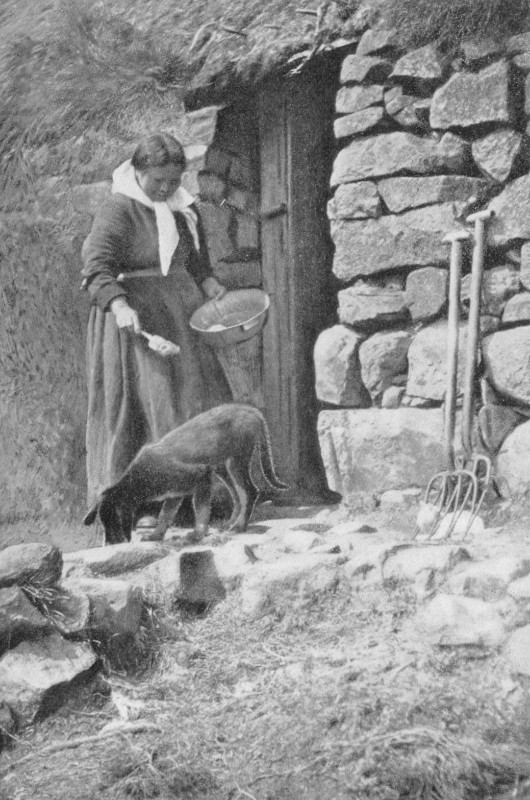 Feeding the Dog The crofters pay yearly rentals of from one to fifteen pounds. This is simply ground-rent, for they themselves erect and own the houses in which they live. On the smaller crofts there is only an acre or so under cultivation, and this is dug over by hand. A crofter, however, who pays a rental above five pounds is pretty sure to have horses and a plough. Some of them have as much as ten acres under cultivation. But few comprehend the philosophy of crop rotation, and through this ignorance the fertility of the land is destroyed. The average crofter keeps a cow and a calf, a small flock of hens, and a number of sheep. He raises a patch of oats, grows a little field of hay and a few square rods of potatoes; and he has the privilege of cutting peat on the bog. Oat cakes, fish, potatoes, and milk are the standard foods, with tea, tobacco, and snuff among the necessary luxuries. Ordinarily the cows are kept in the houses, but a man who has three or four, as do the more prosperous crofters, will have a separate byre for them. The cows are extraordinary looking creatures and seem much more like wild beasts of the forest or desert than domestic animals. They are short and broad, with long, shaggy hair and enormous wide-spreading horns. But their looks belie them, for they are entirely peaceable, and the breed is said to be a very good one. A great deal of the farm labor falls to the lot of the women. I saw them helping in the peat bogs and the hay-fields, and constantly met them on the roads carrying heavy burdens on their backs. The crofts were most of them far from the highways and distant from market. Horses and carts were rare, and the women took the place of beasts of burden to a considerable extent. At the time of year that I was in Skye they were most apt to be loaded with peat, which they carried in creels strapped to their shoulders. The creels were deep, heavy baskets of willow withes woven by the peasants themselves, and they had a capacity of between one and two bushels. Sometimes it was no less than three miles from the peat moss to the croft village. In such a case a woman would stop at intervals to sit and rest, and she would relieve her shoulders of the loaded creel by letting it slip back on a convenient bank or dyke. Many of the women had their knitting along, and when they stopped to rest would set their needles flying. The garments of the croft women were as a rule coarse and ragged, and a colored kerchief did instead of a hat, or else they went about with their frouzy hair flying unprotected. Occasionally they were barefoot; but they seldom go without shoes except around home. Some, however, when they have to walk a long distance carry their shoes in their hands for the sake of economy, to save them from wear, and put them on just before they reach the journey's end. Homespun enters largely into the wearing apparel of the crofters, especially of the men. The wool is carded and spun in every cottage, and at least one house in each village is very certain to have a loom in the kitchen on which is woven the cloth for the neighborhood. The life of the crofters is, as a whole, sober-hued and laborious; and although there are times of recreation, care-free enjoyment and self-forgetting gayety are seldom attained. Of the peasant pleasures, I think weddings, funerals, and the semi-annual communions are chief. These mean much more than in most places, because of the island's isolation. Some of the country weddings are very picturesque affairs. At the home of both bride and groom a company is made up, and the two bands start to meet at a stated time, each with a piper leading off. After they have joined forces they proceed to the manse, where the wedding takes place. Then they return to the village whence they came, the two pipers piping on ahead, the newly married couple following, and a straggling company of relatives and friends bringing up the rear. As the bride and groom are about to enter the door of the house which is to be their home, some one standing in readiness breaks an oat cake, baked brittle for the purpose, over their heads. This is an old charm, supposed to bring the couples an after life of prosperity and plenty. The young people in the wedding party all scramble for pieces of the broken bannock, and they sleep that night with them under their pillows, for in their dreams they can discern future husbands and wives aided by the presence of these bits of bannock just as surely as we in America can with similarly disposed pieces of wedding cake. The evening of the wedding day is devoted to conviviality, and there are abundant refreshments in the shape of sweeties, cakes, and whiskey; and songs are sung, and the bagpipes drone ever and anon to lead the dance. The humbler wedding parties occasionally lack the bagpipes, in which emergency, if no other musical instrument is to be had, some one breathes the melodies for the dancers through a paper-covered comb. Things are still going full blast at midnight, and not infrequently the gray light of dawn is stealing out of the east before the jollification ends. Weddings are too few and far between to furnish any very material brightness — and the crofters are not a merry people. Still, in their way they find an element of holiday recreation in the most solemn occasion, if it brings a company of them together. For this reason even a funeral is not without its modicum of welcome. It makes a break in the monotony, and it never fails to be largely attended. The people, as they arrive, are provided with a sup of whiskey and with oat cakes and cheese or other light refreshments. After a short service at the house the men form in procession to go to the grave. The women remain behind. There is no hearse in the island, and the coffin, covered with a black cloth, is carried on the shoulders of six bearers. The distance is often long — sometimes as much as seven or eight miles — and the rule is for the men bearing the bier to give place to others about three times to a mile. Most notable among the events of the Skye year is the summer communion season. It begins on a Thursday and continues through the succeeding Sunday. The meetings are held out of doors, and many of the throngs which attend are present all four days. Curiously enough, the communion season is marked by a great deal of drunkenness. The crofters in their retired villages, from which they journey only rarely to the larger places, find the facilities for getting drink very limited. Thus, when at home, they seldom taste liquor; but once in the town, even for a religious purpose, the temptation is too much for them. With the exception of this backsliding at the time of the communion gatherings in the matter of drink, the people of Skye observe their religious days with great seriousness and decorum. Indeed, their regard for the Sabbath seemed to me decidedly puritanic. All work ceases, every one attends church, and the indulgence in any form of amusement is held to be a sin. Nothing could have been quieter than was Portree in the early hours of the Sunday I was there; but when the little bells of the village churches began to ring at a quarter to eleven, there was a change. For fifteen minutes the bells kept up an incessant dingdong, and during all this time the town walks were noisy with the clack of heavy shoes moving church-ward. I joined the throng presently, and wended my way to the Free Kirk on the Square. It was a big barn of a building, whose lack of decoration without was echoed by the plain severity of the interior. A large and attentive audience filled the pews. What most impressed me about them at first thought was their decidedly peaty odor. Evidently many of the worshippers came from the smoky cabins of the crofters, though I would not have recognized them as belonging to this class by their dress. They were, in fact, so well clad as to be quite transformed. I learned afterward that the peasants, however poor, consider an outfit of modern and presentable Sabbath garments a necessity, and they will sacrifice a great deal in other directions rather than do without them. 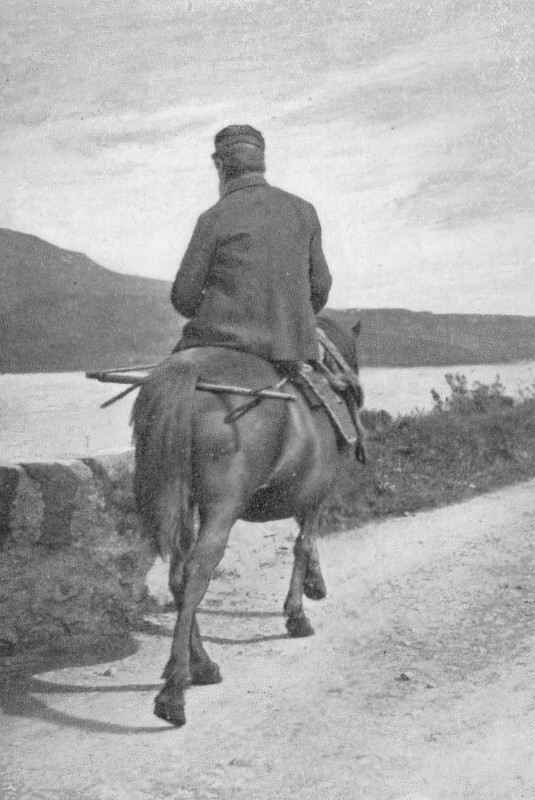 A Rider The Free Kirk service was entirely in Gaelic, and I was not much enlightened by what I heard. In front of the pulpit sat the precentor, a tall, gray man, who, when a psalm was to be sung, stood before us and led the singing. He would first read a line in a chanting monotone, and then every one would fall in and sing it. Then he would read another line, that would be sung, and so on to the end of the psalm. The music was very simple, and I thought it rather formless — not much more than a wailing up and down, with little melody that I could discover. However, perhaps I could not judge, for those pauses between lines must have tended to dissipate the melody pretty thoroughly. Excepting the precentor, the audience sat during the singing, but we all rose and remained standing through the prayers. The service lasted nearly two hours. In the afternoon there was a second service, and in the evening a third. That of the afternoon was in English, and a very different congregation gathered then, largely made up of tradespeople, but they had the same preacher. A choir sat in front of the pulpit where before had been the lonely precentor. I suggested to one of the townsmen that an organ would be a still farther improvement. But he said that the choir itself was a great innovation, and that the large majority of the worshippers would decidedly object to an organ. I was not surprised, for I had found the piano at my lodging-place shut and locked that morning, and had been informed by the maid that the landlady objected to having it played on Sunday, and I had already drawn the conclusion that the sound of a musical instrument was an abomination in the ears of the people of Skye on the Sabbath. The Scotch national costume was more in fashion among the men of Portree than in any town I had visited. A number of the young men wore their kilts to church, and the leading merchant of the place was especially conspicuous in the garb of a Highland chieftain. The gay colors, the sporran hanging down in front, the jaunty cap, and the bare knees made him look quite romantic, while a dirk stuck in his right sock gave him a touch of the savage. One of the villages of the crofters was built along the shore on the borders of Portree. No road led to it, and footpaths served as its only connection with the highway a quarter of a mile up the hill. The slope between the cottages and the road was cut up into long strips, and here the crofters raised their crops. A few of the houses were whitewashed, had chimneys, and looked fairly comfortable, but most had walls of rough stone chinked with earth, and roofs of thatch protected from the onslaught of the gales by a crisscrossing of cords, or perchance by an old fish-net. Frequently the thatch had patches of grass and weeds growing on it, and I saw one roof so covered with rank herbage that it had the appearance as if the house inmates were raising a crop there. Numerous families of chickens and ducks were picking about the rocks of the beach or scratching out a living in the neighborhood of the cottages. Sometimes the henhouse would be a dark little hovel hugging the side of the cottage, sometimes a boat turned bottom upward. There was much refuse about the house fronts, and the beach was strewn with broken clam shells. A narrow, irregular path, just above high-water mark, linked the houses together. It was very rough and muddy, and it turned aside now and then to approach one of the many springs that furnished water for the hamlet. The springs were just as nature made them, except that they had been rimmed around with a few stones to form shallow basins. The poorer of the croft homes are about as humble as they well could be. The floors are of hard-packed earth, and the fire is in the middle of the kitchen on a rude platform of stones six or eight inches high. A hole in the thatch overhead is the only apology for a chimney. In replenishing the fire the embers are poked together and fresh peats are set up on end around the hot coals. A rope or long pole fastened up above to the ridgepole reaches down, so that pots can be hung over the fire on hooks at its lower end. The tea-kettle is kept warm by being set on the hot stones a little to one side. Such a kitchen has no ceiling, but is open to the rafters and crooked stringers of the roof, which are as black as midnight with incrustations and hangings of grime and soot. The furniture is meagre, cheap, and shaky. There are a few chairs that have seen better days and one or two low-backed settles that in the idle spells are much of the time "full of mens," to quote the expression of a peasant woman. The only other prominent features are a chest, a spinning-wheel, and a small unsteady dresser with a row or two of dishes displayed on its racks. I have seen more ornamentation and attention to the amenities of life in some of our American barns than in these homes of the crofters. They are simply hovels to exist in. A number of lines run across the kitchen just high enough to miss the heads of persons stepping around below. These are used for various domestic purposes, but more particularly to hang dried fish on. Windows in the croft homes are few and small, and it seldom happens that a room has more than one. The door is usually open in mild weather to give the smoke an added means of egress, though this does not clear, but only mitigates, the heaviness of the atmosphere. The vapors of the fire penetrate and saturate everything. They affect distinctly the household eatables, both to taste and smell, and they insinuate themselves in every fabric and article of apparel, so that the crofters always carry about with them that heavy aroma of the peat. Let one of them sit in the kitchen of a town residence long enough to have a friendly cup of tea with the cook, and the peat flavor is apparent all over the house. You might think the peasants would get so used to the smoke as not to mind it, but this is not the case. The women, especially, acknowledge to feeling a sick turn when on dull days the smoke lies inside, and it is that, not less than the crowded discomfort of the interior, which drives them to do so much of their spinning outside by the house-walls, their knitting on the near banks, and their washing in the streams. In one of the houses where I stopped an old woman showed me photographs of two intelligent-looking young men whom she said were her sons, now in Australia. All her five children had left the island save one daughter, a cripple who was then sitting by the fire, taking snuff. The old woman was at work carding wool, and many skeins of yellow yarn were hung on the wall behind her. I was having a very agreeable visit, but after she had exhibited her treasured photographs she put fresh peats on the fire, and the smoke became so stifling I hastened to escape. This hamlet by the shore was inhabited by folks who depended largely on fishing for their subsistence. Two miles inland was a more strictly farming community which I one day visited. On the way to it I met several men leading panniered ponies. They were going to Portree to get goods brought by the steamer and carry them back into the country. I followed a narrow road that wound along over the moors. This road had been made only about a year. Previously there had been naught but a faintly marked path. The village to which I journeyed was a scattering of low, thatched huts, so earthy and rough they seemed much like boulders of rock sticking up through the soil. They were planted at random on the hillsides and in the hollows, and the distant view of the crofts, with the patchwork of their small fields, was rather attractive. I went up an almost indistinguishable footway through a spongy bog to a house, where a woman was making a peatstack in the yard. She had been bringing the peats from one of the black cuttings on the moor, and her heavy creel lay near by on the ground. I looked in at the door of the woman's house, and saw a cow and a calf in the dusky interior of an apartment only separated from the family living-room by a wooden partition. 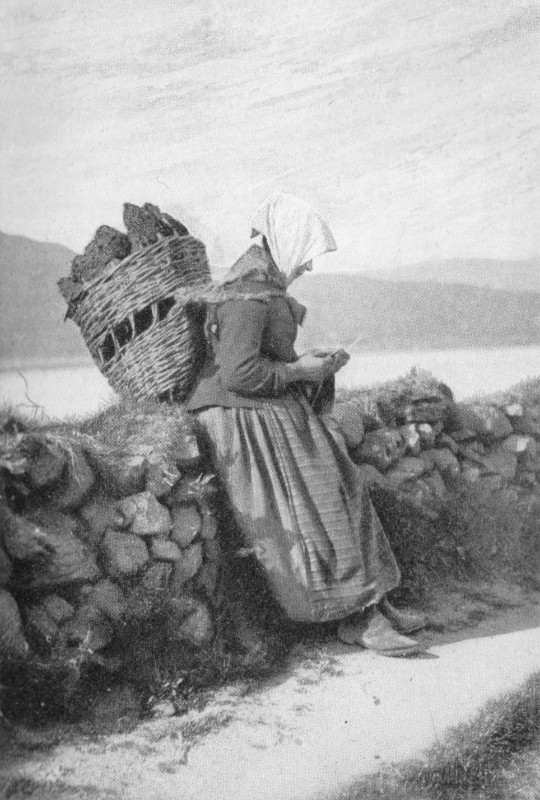 Resting on a Dyke At the next house an old man, smoking a short pipe, and a barefoot woman were sitting talking on a dyke. They had not much command of any language save the Gaelic, but we managed to hold a broken conversation. Presently the woman invited me to have a glass of milk, and led the way to the house. The entrance was at the end, and admitted me first to the byre. The footing was not all it should be here, and the woman sprinkled down some heather to enable me to get safely across the mire to the kitchen beyond. The supply of light for this latter room all came from a tiny, grime-darkened window in the roof and from the distant outer door. It was like being in a cave, and for a time I could hardly see. The woman wiped clean a place on a settle for me to sit, washed a soiled glass, and went into a tiny closet of a bedroom and brought out a bowl of milk. The milk was rich but peaty, and, in the dirt and gloom of the surroundings, not very palatable. The crofters are sadly handicapped by the poverty and forlornness of their environment, but they have marked natural capability, and many of the young people have in other lands achieved wealth and even greatness. One influence which helped in the past to sharpen the croft wits was what was known as the "caly," a sort of open meeting for argument, songs, and stories. The "caly" was held in the cottage living-rooms, one night at one house and another night at some other house. The men when they came in seated themselves in a circle about the fire. The chairman, who was always the man of the house, started the evening's entertainment by relating a story or experience, or by singing a song. Then each man in turn to the right would follow suit. In winter the merriment frequently continued all night. Patriotism and a martial sentiment were cultivated, and the participants acquired much useful information. But at length the ministers began to oppose the caly on the ground that there was too strong a tendency to tell profane stories, and now the caly is wholly extinct. Of the future of the crofters I cannot say from what I saw and heard of them that it appears to hold much brightness. Nature itself in that remote and barren northern island is against them; yet the law has done something of late in alleviating their condition, and may do more. Perhaps the most hopeful sign is the tendency shown to improve their homes. They are abandoning their primeval fireplaces, and building chimneys, and some of the more aspiring have plastered their house-walls and replaced with slate the roofs of mouldering thatch. This has awakened a spirit of emulation, and many others will follow the example set them as soon as they can gather the means. 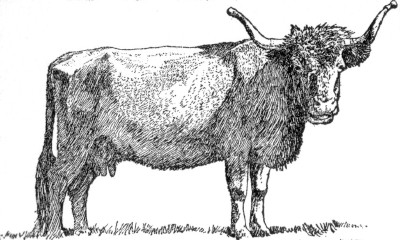 A Highland Cow |